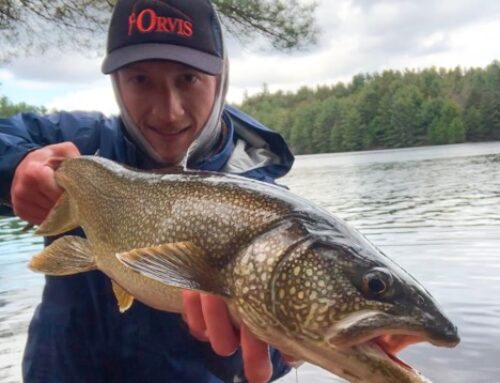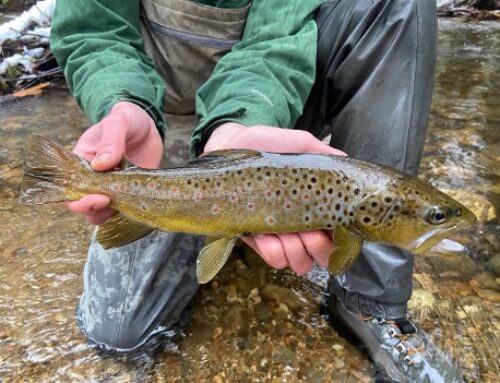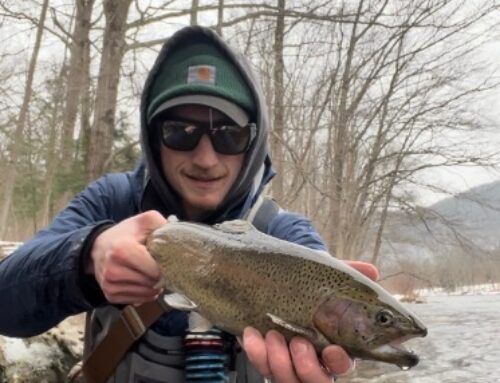‘Tis the season of overwhelming options! There’s a million and one bites to target at this time of year—let’s dig into a few of them.
On the Fife Brook stretch of the Deerfield, flows are down from last week’s high-water event but are still running relatively high especially for wade angling, about 1100 CFS as this report is being written. With more rain forecasted in the days ahead, it’s likely that we won’t see Fife go much lower than this flow rate and could definitely see it spike again. On the lower stretches, flow conditions directly below dams #4 and #3 are manageable for the moment, however, expect a bump with the incoming rain. As for the stretches below, flows are running a bit high but manageable around 2000 CFS. Keep in mind that the river’s channel on the lower stretches is wider than it is higher up on the river so flow rates that would be very high further up aren’t as difficult to navigate down low. Again, though, expect a bump with the incoming precipitation.
The Deerfield has really come to life in the past couple weeks as water temperatures have crept up into the 50s, triggering the season’s first major hatches, especially lower down in the system where the water is a bit warmer. Quill Gordons and Hendricksons have been observed along with solid numbers of caddis and some stones here and there. The high water can make targeting these hatches on surface a bit tricky but there should still be some dry fly opportunity if you know where to look. It’s a good idea to focus attention on areas of slower water like eddies and structure obstructions where a lot of bugs—and especially emerging mayflies—will drift into making an easy meal near the surface.
Keep in mind that the mayflies coming off are pretty big, usually around #14-16 for quill Gordons and #12-14 for Hendricksons, so make sure to take that into account for fly selection. Some good patterns to keep in the box for these imitations are parachute and Catskill-style Adams, klinkhammmers, sparkle duns, CDC-winged emergers and the like. As for caddis, you can never go wrong with the classic elk hair caddis, but an X-caddis or a Galloup Butch caddis should also play well among other options. The caddisflies coming off are generally tan in sizes #14-16, so keep that in mind for fly selection.
It’s also a good idea to consider throwing dry-dropper rigs, a system in which a fly, often a weighted nymph, is dropped off a relatively buoyant dry fly. This rig kills two birds with one stone as the dry fly acts as a strike indicator for the nymph below while also presenting a viable meal itself. In the high water, you will likely need to select a heavy dropper nymph to get to the appropriate depth, so keep that in mind when selecting a dry fly (i.e. make sure your dropper isn’t sinking your dry). When in doubt, you can’t go wrong with a high floating pattern like a chubby Chernobyl. It may seem a bit early for such imitations, however, local guides are already reporting some action on big, foamy flies and it’s only going to get better from here. As for dropper nymph selection, consider that more surface area equals a slower fall rate, so slender, heavily weighted patterns like a perdigon or Frenchie are smart choices. All in all, dry/hopper-dropper rigs can all but replace indicators in many situations and are arguably way more fun to fish, so keep that in mind going forward.
All this being said, the higher flows and warmer water present solid streamer opportunities as well. Sinking line systems will be all but necessary in order to deliver flies to the appropriate depth with the high water, even when using a weighted streamer. We carry a variety of full sink and sink tip lines in the shop, however, if you’re not yet ready to make the investment in a sinking system, we also carry Rio’s sinking Versi-leader which can be attached to a floating line. As for streamer selection, many patterns will get the job done, but we generally find it best to start out pretty big and size down as necessary.
In terms of matching the hatch, consider that sculpins spawn around this time and present one of the river’s top forage options especially for larger, wild trout. As we said in last month’s report, sculpin are very bottom-oriented, however, they can be flushed out of holds along the riverbed and up into the water column, an opportunity that many of the river’s larger trout keep a sharp eye out for. Fulling Mill’s bank robber is a great option for such an imitation, however, Galloup’s zoo cougar has stood the test of time for imitating this pattern for a reason. Speaking of the zoo cougar, we just re-did our streamer bin in the shop and have added a bunch of new patterns and colorways including the zoo cougar. Make sure to stop by the store to check out the new selections.
One final word on the Deerfield: Keep in mind that the area upstream of the Zoar Gap will not be stocked this year. This fact will likely make for some tougher fishing in terms of numbers depending on holdover rates and how many stocked fish make their way from the lower sections of Fife Brook past the Gap and into the upper reaches. This decision is quite controversial, but the good news is that when you do hook up, the chances that it will be a wild brown are significantly greater. Reach out with any questions regarding the new stocking policy.
Elsewhere on the Millers River, flows are pretty unfishable at the moment with a rate just under 2500 CFS as this report is being written. The Millers takes a while to drain and with more rain on the way, it’s likely that conditions will not improve in the immediate future. The good news is that the high water has likely distributed newly stocked fish pretty widely, which should make for ample opportunity throughout the river’s course when flows do recede. While we’re looking ahead, also keep in mind that the Millers offers a solid smallmouth fishery, an opportunity that will become increasingly relevant as flows drop and water temperatures rise. The Millers tends to heat up pretty significantly into the summer, with temperatures high enough to eliminate trout opportunities altogether. If and when we reach this point, the river’s plentiful population of smallies offers solid opportunities both above and below the surface.
On the Westfield River, flows are receding after last week’s high-water event, however, expect a bump with the incoming rain. Reports have reflected relatively tough fishing on the Westfield despite the fact that the river has been amply stocked. This being said, the entire system was stocked again on May 13, so we’ll see if things pick up a bit. We haven’t heard much in terms of hatch but with water temperatures creeping up into the ideal range, expect that more bugs will be coming off soon if they haven’t started already. With a healthy mix of both newly stocked and more naturalized fish in the system, it will be important to understand how your approach should change depending on what and who you’re targeting. Keep in mind that newly stocked fish which have not yet learned to feed naturally are best targeted with eggs and small streamers, while fish that have been in the system a while will likely be drawn to more natural presentations like hatch-matching nymphs and dry flies. This being said, a small streamer is still a solid option in any situation.
Below Quabbin on the Swift River, things are gradually starting to improve after a very tough start to the season. Throughout the end of winter and the beginning of spring, the river seemed virtually devoid of fish despite several rounds of stocking. Save for the usual populations around the Y-pool and the pipe, you would have been pretty hard-pressed to find fish throughout the start of the year. In the last week or two, though, some fish have started to come back around. We’ve received reports of activity and surface feeding around the Cady Lane area which should inspire some hope. Additionally, the word from the float guides is that there are solid numbers present both above and below the boat launch on Cold Spring Road. While reports of significant activity from both otters and poachers have been prevalent, it would seem that the damage is not as severe as originally thought.
The Swift’s sulphur hatch—one of the most consistent hatches in the entire fishery—is quickly approaching and the hope is that the imminent arrival of these beautiful orangey yellow mayflies will further distribute the river’s trout. In the event the sulphurs do pull these fish out of their funk and back into normal lies, this hatch is arguably best fished with early stage emergers and cripples. While later stage patterns like parachutes can get the job done, its usually the more vulnerable-looking imitations which convert risers to catches best. Swift sulphurs usually average around #18, however, we find it best to go a size or two smaller; for whatever reason, this approach just flat out works the best.
In terms of rigging, plying the Swift’s surface is notoriously difficult and technical, however, is not as hard as it’s made out to be once you get the hang of it. While many will tell you that you need a 0 wt. rod and specialty 9x tippet to turn a single head, the reality is that a 3 or 4 wt. with 6x will get the job done. The most important factor is arguably the leader system, which very simply just needs to be long enough to supply ample separation between the fly and the fly line. We recommend starting with a 12-foot 6x tapered leader and then tying on about a foot or two of 6x (MAYBE 7x) tippet to the fly. The real challenge is just getting such a long leader system to turn over, so it’s a good idea to practice in the backyard a bit.
Outside of the big/major rivers, the small water bite is white hot at the moment. Creeks in the Pioneer Valley and further east are absolute bug factories right now with significant hatches of several distinctions coming off in considerable numbers. Small water in higher elevation to the west is a little behind with cooler water temperatures and more limited bug activity, but these streams should also be perking up in a major way very soon.
As for approach, dry droppers are the answer with lots of fish willing to take presentations both on and below the surface. There’s no need to get crazy complicated with fly selection as many creek fish both wild and stocked will have a go at just about anything that’s properly presented. Simply select a high floating dry fly that can both float a dropper nymph and withstand the abuse of lots of eats; good examples would be a PMX or humpy. For nymph selection, consider that the ultimate goal is to get the fly to depth as quickly as possible in the limited real estate most creeks present. Patterns with slender profiles/minimal surface area like a Quasimodo or pheasant tail, perdigon, Walt’s worm and the like do an excellent job in this regard. A good strategy to get dropper nymphs down as quickly as possible is to cast into plunges above the selected drift where the downwards pressure of the plunge forces the nymph to depth—just be careful not to drown your dry fly in the process.
Outside the world of trout, there’s definitely a lot going on at this time of year. The pre-spawn smallmouth window is likely getting narrow on the lower stretches of the Deerfield, Westfield, and Millers rivers as water temperatures creep up into the spawning range. It’s likely that male bass have already begun to stage on beds while the larger females continue to mill around spawning areas looking for meals before they join the males on the beds. Accessing these areas can be pretty tricky and is even more difficult with high water, but it’s worth it to do some exploring while there is still an open window of opportunity. In terms of approach, it’ll be a smart idea to equip yourself both with a heavier sinking line for throwing streamers and craw patterns as well as a floating or intermediate setup for throwing upper column bugs like a swinging D or fathead deceiver. Perhaps most importantly in terms of approach though is identifying key areas to target at this point in the spawning process. Bass will generally seek out gravel bottom in which to dig their beds, so it’ll be a smart idea to identify and thoroughly work such areas of the river(s).
As for bass opportunities on still water and specifically the big reservoirs (Quabbin and Wachusett), the smallmouth spawn usually runs a little behind spawning activities in the rivers so the window of opportunity for big pre-spawn females remains wide open. Whether fishing from shore or a boat, you’ll generally want to be targeting depths of about 10-20 feet with adjacency to both shallower gravel as well as deeper drop offs. Your best bet will be to throw streamers and craw patterns on a sinking line, however, action further up in the water column is not out of play so experiment and see what works.
Another intriguing pattern to think about at this time of year is the flood plains of the Connecticut River. The river proper is unfishable right now with a flow just under 30,000 CFS as this report is being written, however, both carp and pike will move up into the shallows of wooded flood plains to seek shelter from the high water and to search out feeding opportunities. This pattern is very difficult to target on foot and is best fished from a kayak or canoe, but some pretty big fish can be had in these tight quarters. As a cursory reminder, be careful to check that you’re not on private property while navigating such areas.
Off the water, remember that we will be holding drop-in fly tying every Saturday starting at 10:30 AM. These are free form sessions so just bring your vise, tools and materials for anything you’d like to tie. Other than that, keep eyes peeled for more programs and events coming soon. As always, thank you for your continued support from all of us here at the Deerfield Fly Shop and we wish you luck next time you’re on the water.










